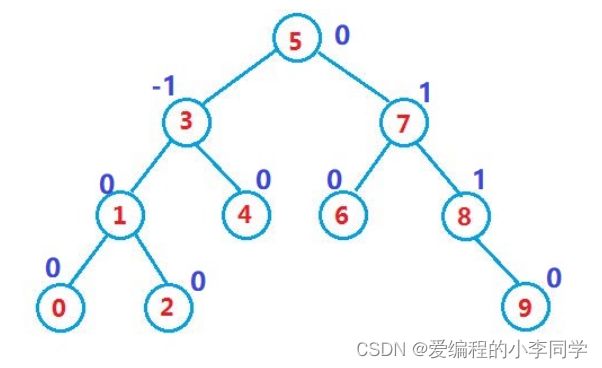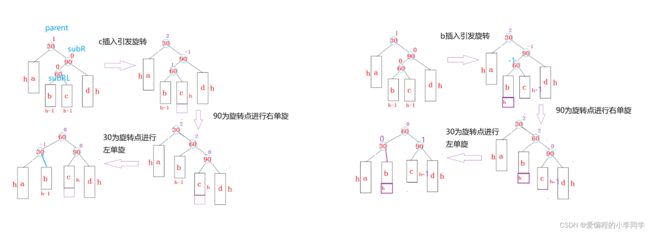C++实现AVL树
C++实现AVL树
- 前言
- 一、AVL树的概念
- 二、AVL树节点的定义
- 三、AVL树的插入操作
- 四、AVL树的旋转
-
- 1. 左单旋
- 2. 右单旋
- 3. 左右双旋
- 4. 右左双旋
- 5. 总结
- 五、AVL树的验证
-
- 1、验证其为二叉搜索树
- 2、验证其为平衡树
- 六、AVL树的性能分析
- 实现AVL树的完整代码
前言
二叉搜索树虽可以缩短查找的效率,但如果数据有序或接近有序二叉搜索树将退化为单支树,查找元素相当于在顺序表中搜索元素,效率低下。因此,两位俄罗斯的数学家G.M.Adelson-Velskii和E.M.Landis在1962年发明了一种解决上述问题的方法:当向二叉搜索树中插入新结点后,如果能保证每个结点的左右子树高度之差的绝对值不超过1(需要对树中的结点进行调整),即可降低树的高度,从而减少平均搜索长度。
一、AVL树的概念
-
AVL树的名字来源于它的发明作者G.M. Adelson-Velsky 和 E.M. Landis。AVL树是最先发明的自平衡二叉查找树(Self-Balancing Binary Search Tree,简称平衡二叉树)。
-
AVL树的定义:它或者是一颗空树,或者具有以下性质的二叉排序树:它的左子树和右子树的深度之差(平衡因子)的绝对值不超过1,且它的左子树和右子树都是一颗平衡二叉树。
-
AVL树的性质:
- 它的左右子树都是AVL树
- 左右子树高度之差(简称平衡因子)的绝对值不超过1(-1/0/1)

如果一棵二叉搜索树是高度平衡的,它就是AVL树。如果它有n个结点,其高度可保持在 O ( l o g 2 n ) O(log_2 n) O(log2n),搜索时间复杂度 O ( l o g 2 n ) O(log_2 n) O(log2n)。
二、AVL树节点的定义
AVL树节点的定义:
template<class K, class V>
struct AVLTreeNode
{
pair<K, V> _kv;
AVLTreeNode<K, V>* _left; //该节点的左孩子
AVLTreeNode<K, V>* _right; //该节点的右孩子
AVLTreeNode<K, V>* _parent; //该节点的双亲
int _bf; //平衡因子
AVLTreeNode(const pair<K,V>& kv) //构造函数
:_kv(kv)
,_left(nullptr)
,_right(nullptr)
,_parent(nullptr)
,_bf(0)
{}
};
三、AVL树的插入操作
AVL树就是在二叉搜索树的基础之上引入了平衡因子,因此AVL树也可以看出是二叉搜索树。那么AVL树的插入过程可以分成两部分:
- 按照二叉搜索树的方式插入新节点
- 调整平衡因子,若遇到平衡因子不符合AVL树的规则,则需要进行旋转操作
bool Insert(const pair<K, V>& kv)
{
// 1、搜索树的插入规则
// 2、看是否违反平衡规则,若违反则需要“旋转”处理
if (_root == nullptr)
{
_root = new Node(kv);
_root->_bf = 0;
return true;
}
Node* parent = nullptr;
Node* cur = _root;
while (cur)
{
if (cur->_kv.first < kv.first)
{
parent = cur;
cur = cur->_right;
}
else if (cur->_kv.first > kv.first)
{
parent = cur;
cur = cur->_left;
}
else
{
return false;
}
}
//找到了插入位置
cur = new Node(kv);
if (parent->_kv.first < kv.first)
{
parent->_right = cur;
}
else
{
parent->_left = cur;
}
cur->_parent = parent;
//更新平衡因子
while (parent) //最远更新到parent
{
if (cur == parent->_right)
{
parent->_bf++;
}
else
{
parent->_bf--;
}
//判断是否继续更新
if (parent->_bf == 0)
{
break;
}
else if (parent->_bf == -1 || parent->_bf == 1) // 此时插入结点的那边变高了
{
//继续更新祖先
cur = cur->_parent;
parent = parent->_parent;
}
else if (parent->_bf == -2 || parent->_bf == 2) // 插入结点使得本来高的一边又变高了 -> 旋转
{
if (parent->_bf == 2 && cur->_bf == 1) // 左单旋
{
// 左单旋
}
else if (parent->_bf == -2 && cur->_bf == -1) // 右单旋
{
// 右单旋
}
else if (parent->_bf == -2 && cur->_bf == 1) // 左右双旋
{
// 左右双旋
}
else if (parent->_bf == 2 && cur->_bf == -1) // 右左双旋
{
// 右左双旋
}
else
{
assert(false);
}
break;
}
else
{
assert(false); // 树本来就存在问题
}
}
return true;
}
四、AVL树的旋转
如果在一棵原本是平衡的AVL树中插入一个新节点,可能造成不平衡,此时必须调整树的结构,使之平衡化。根据节点插入位置的不同,AVL树的旋转分为四种。
1. 左单旋
新节点插入较高右子树的右侧—右右,即需要左单旋。
void RotateL(Node* parent)
{
Node* subR = parent->_right;
Node* subRL = subR->_left;
parent->_right = subRL;
if(subRL)
subRL->_parent = parent;
Node* grandParent = parent->_parent;
subR->_left = parent;
parent->_parent = subR;
if (parent == _root)
{
_root = subR;
subR->_parent = nullptr;
}
else
{
if (parent == grandParent->_left)
{
grandParent->_left = subR;
}
else
{
grandParent->_right = subR;
}
subR->_parent = grandParent;
}
subR->_bf = parent->_bf = 0; //更新平衡因子
}
2. 右单旋
新节点插入较高左子树的左侧—左左,即需要右单旋。
图示:

右单旋代码:
void RotateR(Node* parent)
{
Node* subL = parent->_left;
Node* subLR = subL->_right;
parent->_left = subLR;
if (subLR)
subLR->_parent = parent;
Node* grandParent = parent->_parent;
subL->_right = parent;
parent->_parent = subL;
if (parent == _root)
{
_root = subL;
subL->_parent = nullptr;
}
else
{
if (parent == grandParent->_left)
{
grandParent->_left = subL;
}
else
{
grandParent->_right = subL;
}
subL->_parent = grandParent;
}
subL->_bf = parent->_bf = 0;
}
3. 左右双旋
新节点插入较高左子树的右侧—左右,即需要先左单旋再右单旋。
图示:

此时在60的子树插入一个新节点就会引起左右双旋,插入分为左子树插入和右子树插入。这两种情况的插入完成之后对其平衡因子的更新有所不同,因此旋转完成后需要讨论更新其平衡因子。

实现代码:复用左、右单旋。
void RotateLR(Node* parent)
{
Node* subL = parent->_left;
Node* subLR = subL->_right;
int bf = subLR->_bf;
RotateL(parent->_left);
RotateR(parent);
//更新平衡因子
if (1 == bf)
subL->_bf = -1;
else if (-1 == bf)
parent->_bf = 1;
else
{
assert(false);
}
}
4. 右左双旋
新节点插入较高右子树的左侧—右左,即需要先右单旋再左单旋。
右左双旋与左右双旋类似。

代码实现:
void RotateRL(Node* parent)
{
Node* subR = parent->_right;
Node* subRL = subR->_left;
int bf = subRL->_bf;
RotateR(parent->_right);
RotateL(parent);
//更新平衡因子
if (1 == bf)
{
parent->_bf = -1;
}
else if(-1 == bf)
{
subR->_bf = 1;
}
else
{
assert(false);
}
}
5. 总结
假如以parent为根的子树不平衡,即parent的平衡因子为2或者-2,分以下情况考虑
- parent的平衡因子为2,说明parent的右子树高,设parent的右子树的根为subR,当subR的平衡因子为1时,执行左单旋;当subR的平衡因子为-1时,执行右左双旋。
- parent的平衡因子为-2,说明parent的左子树高,设parent的左子树的根为subL,当subL的平衡因子为-1是,执行右单旋;当subL的平衡因子为1时,执行左右双旋。
- 旋转完成后,原parent为根的子树个高度降低,已经平衡,不需要再向上更新。
五、AVL树的验证
AVL树是在二叉搜索树的基础上加入了平衡性的限制,因此要验证AVL树,可以分两步:
1、验证其为二叉搜索树
如果中序遍历可得到一个有序的序列,就说明为二叉搜索树。
验证代码如下:
void InOrder()
{
_InOrder(_root);
cout << endl;
}
void _InOrder(Node* root)
{
if (root == nullptr)
return;
_InOrder(root->_left);
cout << root->_kv.first << " ";
_InOrder(root->_right);
}
2、验证其为平衡树
验证规则:
- 每个节点子树高度差的绝对值不超过1(注意节点中如果没有平衡因子的情况)
- 节点的平衡因子是否计算正确
验证代码如下:
bool IsBalanceTree()
{
return _IsBalanceTree(_root);
}
bool _IsBalanceTree(Node* root)
{
// 空树也是AVL树
if (nullptr == root)
return true;
// 计算root节点的平衡因子:即root左右子树的高度差
int leftHeight = _Height(root->_left);
int rightHeight = _Height(root->_right);
int diff = rightHeight - leftHeight;
// 如果计算出的平衡因子与root的平衡因子不相等,或者
// root平衡因子的绝对值超过1,则一定不是AVL树
if (abs(diff) >= 2) //每个节点子树高度差的绝对值不超过1
{
cout << root->_kv.first << "节点平衡因子异常" << endl;
return false;
}
if (diff != root->_bf) //节点的平衡因子是否计算正确
{
cout << root->_kv.first << "节点平衡因子不符合实际" << endl;
return false;
}
// root的左和右如果都是AVL树,则该树一定是AVL树
return _IsBalanceTree(root->_left) && _IsBalanceTree(root->_right);
}
六、AVL树的性能分析
- AVL树是一棵绝对平衡的二叉搜索树,其要求每个节点的左右子树高度差的绝对值都不超过1,这样可以保证查询时高效的时间复杂度,即 O ( l o g 2 n ) O(log_2 n) O(log2n)。
- 但是如果要对AVL树做一些结构修改的操作,性能非常低下,比如:插入时要维护其绝对平衡,旋转的次数比较多,更差的是在删除时,有可能一直要让旋转持续到根的位置。因此:如果需要一种查询高效且有序的数据结构,而且数据的个数为静态的(即不会改变),可以考虑AVL树,但一个结构经常修改,就不太适合。
实现AVL树的完整代码
#pragma once
#include

